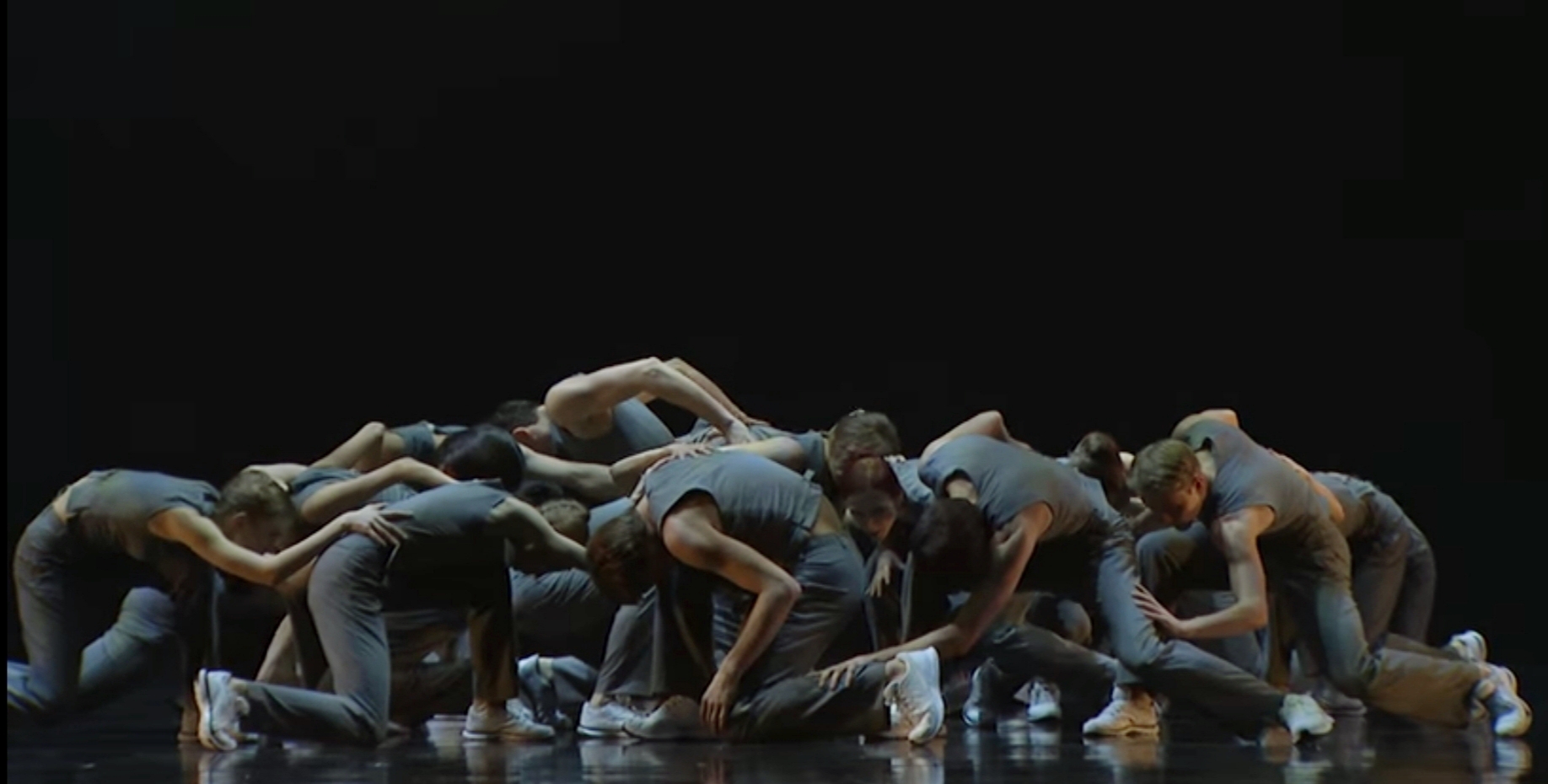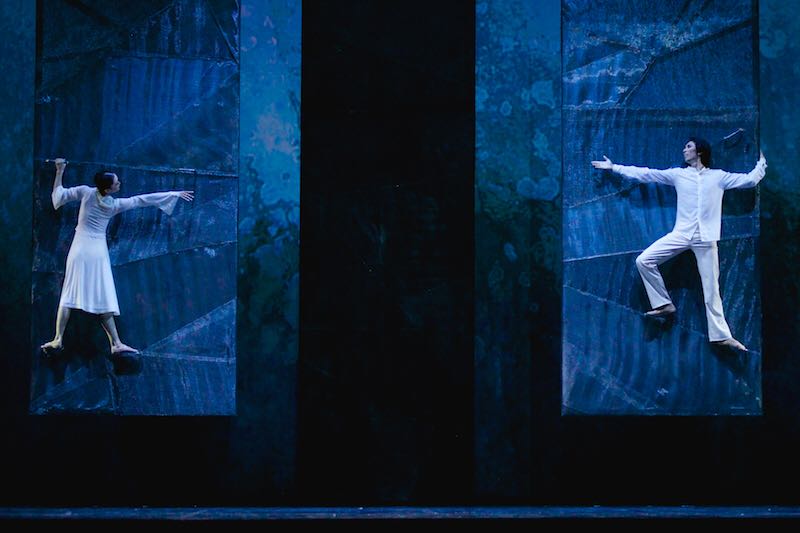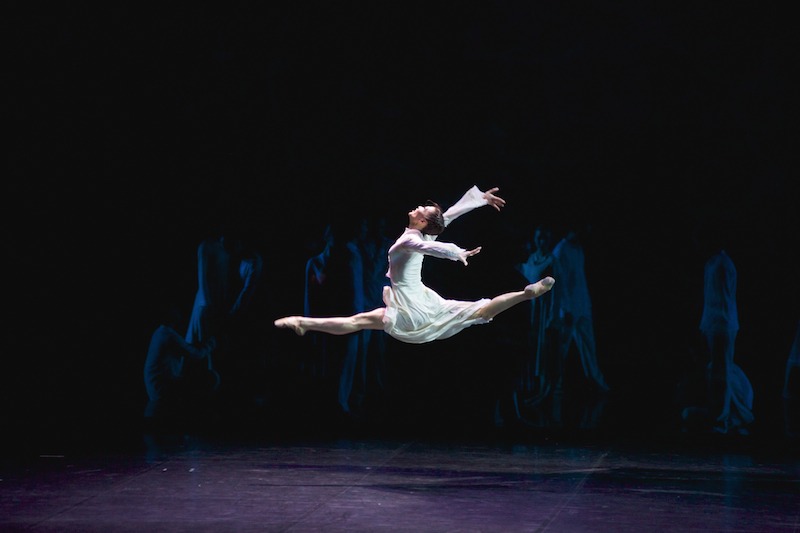- 04/08/2016 by Alexandra Boykova saint-petersburg.ru
Forge of talents: the creative workshop of young choreographers at the Mariinsky Theater
- "Labyrinth" by Ksenia Zvereva showed the most modern choreography. Streaming, soft as plasticine, indissoluble, flowing into different states. And if the plot of this performance was drawn more complicated than the first, then the choreography itself looked more interesting and unusual. Interestingly, the dancers of the corps de ballet and the soloists - practically everyone - could show themselves in it exclusively from the best side. The discovery of this ballet was the extraordinary grace of Elena Evseeva."

" Elegy. Ophelia". Her second piece Ksenia Zvereva choreographed for the prima ballerina Viktoria Tereshkina and one of the best soloists of the company Andrey Ermakov . To get access to such artists for your choreography is already a great success. To create a quality semantic strong piece is a double success. The last ballet of the program was at the highest level - it can directly be taken to any theatre in the world ".

- 04/12/2016 by Alyona Churikova cleverrussia.ru
Road to the young!

"The most striking was the ballet "Labyrinth" by Ksenia Zvereva. "Life is difficult to understand" says a voice behind the scenes in English - a tribute to the modern culture, reflected in the production. A group of young people dances right in their shoes, reminiscent of white sneakers for hip-hop performers. Mixing the music of Franz Schubert and Andrey Martynov creates an interesting collage that complements what is happening on stage.
Dancers seem to be trying to comprehend and understand what is happening in life, inventing more and more new figures, experimenting with a glowing sign of an interesting and unusual shape, then pulling up on it, then looking in its opening, like in a mirror. As a result, the labyrinth remained not passed, the life not comprehended to the end, but the search itself was fascinating and charmingly beautiful, filled with ballet grace".
- 12/06/2018 by Victor Ignatovafficha-paris.com
PREMIERES AND TRIUMPHES: WORLD BALLET FESTIVAL - BENOIS DE LA DANSE 2018
- PAS DE PETIPA
June 6th, 2018, Bolshoi Theater of Russia, Moscow.

The event of the evening was the spectacular miniature "Pa de Petipa", created by Ksenia Zvereva to music by P. Tchaikovsky, from the second and third acts of "Swan Lake". The ingenious piece was brilliantly performed by principal dancers of the Mariinsky Theatre - Oksana Skorik and Xander Parish. They showed a fascinating story of creation of a ballet. On the gloomy stage, a gentleman in a black frock coat with a stick appears, as if personifying Tchaikovsky himself. Suddenly he sees a beautiful image of a ballerina, who embodies both the white and the black swan. Tchaikovsky throws off his coat, and to the wondrous sounds of the violin, a charming duet begins against the background of a glow of cosmic constellations. The ballerina seduces the composer and strong feelings flashes in him. In the dramatic final, the two-faced heroine pushes Tchaikovsky away, hands him his frock coat, presents a feather from her tutu and proudly, with a sense of accomplishment, disappears in the wings.
Zvereva's inspirational talent clearly manifested itself in the unusually organic and delicate relationship of her avant-garde innovative choreography with dance vocabulary and genius stylistics of Marius Petipa - Lev Ivanov. The author of such an amazing miniature managed not only to show the impressive transformation of the white and black swan, but, first of all, to revive the creative spirit of Petipa, the greatness and immortality of his art!
- 30/07/2018 by Flura Musinawww.kazpravda.kz
A dialogue with time in ballet vocabulary
- Novelty and uniqueness of the new productions became the very special achievemnts. The new works were staged specially for the ballet company of the Astana Opera, the first by the well known German choreographer Raimondo Rebeck, the second by the young talented Russian choreographer Ksenia Zvereva.
The metropolitan stage, of course, is not a place for experimens, so the choice of choreographers was carried out carefully, proceeding from the high status in the ballet world of the Artistic Director of the company Mrs Altynai Asylmuratova, whose impeccable taste and professional demands have become a legend. The innovative project was held with the support of the Ministry of Culture and Sports of the Republic of Kazakhstan and JSC "Kazakh Auendery" to the 20th anniversary of the capital.
Accidentally or not, but both ballets somehow explored the theme of time. The introverted philosophical performance of Raimondo Rebeck plunged us into the depths of memory, where the hands of the internal clock run over the most intimate memories of life, while the extrovert Ksenia Zvereva traveled boldly in time and space, changing epochs and realities, combining the legends of distant antiquity with modernity. Each in its own way opened for us the mysterious curtain of Time.
Games with the time
Ksenia Zvereva presented her thoughts about time and space in the ballet Sounds of Time to music by Aktoty Raimkulova, based on Adam Kapanov’s libretto ”Celestial nomad camp”. A fairy tale´s libretto about the beautiful peri, air nomads, descending to the earth once a millennium, to join and www the fate with human beings, was radically reworked by the Russian choreographer. “My goal was to modernize the traditional story as much as possible, to transfer the history of the ancient legend to this very moment and time, but also to show it through the prism of the ages,” - says Ksenia.

According to the author's intention, the ballet was opened and completed by storytellers - the legendary group “Turan” in luxurious ethnic costumes immediately set the tone for the story not only figuratively but literally: low frequencies of throat singing, sounds of kobyz and other ancient instruments immersed the audience in the "traditions of long-forgotten days." The video projection of the Italian set designer Riccardo Massironi succinctly retells the prologue legend, and here the intersection with the libretto of "Celestial nomad camp” ends.
With the raising of the curtain, the action rapidly shifts to nowadays. The bright, lifeaffirming paintings by Yerbolat Tolepby flashes on the portals and the backscreen, and a completely different story begins.
Sounds of Time
A graduate of the Vaganova Ballet Academy in St. Petersburg. Ksenia Zvereva has a solid education in the field of contemporary dance: she thoroughly studied modern in Sweden, underwent an internship with the famous NDT in the Netherlands, participated in many foreign projects as a choreographer. The track record of a young choreographer is striking, as is her mobility and ability to work in a variety of time and geographical conditions.
Overcoming the narrative of the plot, the choreographer transfers the action from one space to another, from legend to reality, from the aul to the city, from truth to fiction. No sooner had Nuria (Anel Rustemov) and Ansar (Olzhas Tarlanov) met, and only the first feelings (touchingly expressed by the choreographer in the contemporary technique) were timidly born and the young lovers exchanged the talismans (Tumar), as the next scene takes us to the city. We hear the sounds of blues, and soon beautiful divas in evening dresses dance tango against the background of a night city. The viewer's eye involuntarily draws a lady in red - Alais (Anastasia Zaklinskaya).
Not only the audience is fascinated by her, but also Ansar, who by the will of fate finds himself in the city. A simple love triangle serves as a reason for a dramatic denouement, and in choreography for the desperate monologue of Nuria, perfectly performed by Anel Rustemova, as well as for the choreographic trio of the main characters - Nuria, Alais and Ansar. There are also dark forces in this story - “guys born with a silver spoon in their mouth” led by the cynical Gunnar (Zhanibek Imankulov). Love, treachery, betrayal and death - the owner of air nomad´s magic Nuria kills Gunar, who is pursuing her, but this frightens and makes peers turn away from her.
The final remains open, and that is its strength. The most capacious scene in the performance is when Nuria, from which friends and beloved had turned away, stops by herself the huge tumar - an ancient astronomical instrument of nomads, which helped to navigate by the stars and counting time. The time has stopped and the space has curtailed, not having found earthly happiness, Nuria returnes to the air nomad ...
It is surprising how in such a short time the composer Aktoty Raimkulova managed to write almost a new ballet score that organically combines the modernity of form and the deep traditions of Kazakh music. In fact, the composer wrote a completely new ball different in form and content. The problem of modern national performances is one of the most topic in the domestic choreographic art. The Astana Opera contributed to its solution by presenting a new modern ballet to a symphonic music by one of the biggest composers of Kazakhstan. Full audience, endless applause and a lively discussion of what the audience saw after the performance - all this is an indication that the main theater still holds a very high professional level, while remaining open to everything new and is not afraid to engage in a dialogue with time.
- 17/07/2018 by Tengri News tengrinews.kz
One-act ballet Sounds of Time. Interview

There are only a few days left before the premiere of Evening of Modern Choreography at the Astana Opera theatre. It is known that the repertoire of the theater consists mainly of classical works. However, towards the end of the season, on the initiative of the Artistic Director of the ballet company, People’s Artist of Russia Mrs Altynai Asylmuratova, it was decided to surprise the audience with unusual exclusive ballets. Ksenia Zvereva – choreographer of the ballet Sounds of Time, spoke with us about her work.
The project is implemented with the support of the Ministry of Culture and Sports of the Republic of Kazakhstan for the 20th anniversary of the capital.
- Ksenia, how long have you been planning to stage such a ballet?
- Of course, there were ideas. I am glad that I was offered to implement them here, at the Astana Opera. We are working on a narrative ballet on a national theme with the composer Aktoty Raimkulova. The story of the ballet is based on the motifs of the libretto by the Kazakh writer Adam Kapanov ”Celestial nomad camp”. In preparations for this project, I learned a lot of national culture, imbued with the traditions of the nomadic people. All this helped me to set the ballet Sounds of Time. It ended up in a non-traditional style and with a non-traditional story. We transfered the action into modernity, which will allow each person in the audience, as well as on stage, to recognize himself. The libretto has a lot of magical details, magical interweavings, and on stage everything comes as close as possible to reality. The performance shows our world nowadays and its current problems, relationships between people, different sectors of society and their values. We will see the interweaving of myth and reality.
- You have already worked with the ballet company of the Astana Opera, how do you evaluate the level of artists?
- The uniqueness of this ballet lies in the fact that it is staged specifically for the Astana Opera ballet. I am pleased to work with Kazakh artists, I see that they are very interested. When a person has a desire, he can do a lot. Before that, I had already worked with the soloists of the Astana Opera, not once, so the company is familiar to me. However, the choreographical vocabulary and style are new for them, so we are rehearsing a lot. And I must mention that the dancers are very enthusiastic, they suggest how they would like to make certain movements, to convey emotions. They do not expect me to fully explain everything, I really want them to feel a certain freedom and not be afraid of taking risks. I have a pretty clear structure, but I am letting the dancers to open up, I try to listen to their desires. Creativity is always a synthesis of ideas.
- How equivalent are the technique and improvisation in your choreography?
- Initially, I create the choreographic text in the studio, trying different movements, changing, adding… And that is based completely on improvisation. Only after that I start to work with the dancers , and they can interpret the movements in their own way, with a different feeling for example. So the final version of the steps/choreography can be something completely new and unpredictable, if you compare with the very firts sketches. And I must say that I am used to change and add some details right till the very day of the premiere…! I constantly ask the dancers to use the ability to expand the boundaries and not get hung up on stereotypes. In classical ballet everything is very accurate and strict, in modern dance – the opposite. Improvisation is an important component, but I have a very clear structure as a basic. And inside that structure you can expand.
- Does this mean that there are more restrictions in the classical ballets?
- Definitely. If we consider the modern dance, you can be sure that there is so much more freedom here. For example, very often choreographers works with abstract themes instead of a narrative plot. Respectively, that allows the choreographer to use his own imagination even deeper and follow his own wills, expoloring indtead of obeying, as to say. As another example, in classical productions the dancers always have specific roles and characters. In modern works – not all the time. So, that gives more flexibility and freedom also to the dancers. You can find different subtexts, approaches, and express it in your own way. That way of creating is also close to me.
In the case today (with the ballet Sounds of Time) we have a narrative ballet with an existing libretto and specially written musical score – these are the basics. The choreography must be “embedded” in the story with many characters. Here you need to be able to work not only in your usual vocabulary, but to make each character individual, with its own leitmotif, characteristcs, and this should also be reflected in the choreography, of course. The boundaries creates certain complexity, but also an interest. When you´re working on a narrative ballet with a storyline, you must pay attention that not only the movements and their inspiration are important, but the actual meaning of the movements. You must create a “talking” choreography, where each step and gesture explains and is reflected in the story. So, yes, a plot entails a particular framework and boundaries, even in a contemporary ballet, but inside those boundaries and ”rules” one can find freedom. It is challenging, trying and exploring something you are not so used to. But that´s how you stay creative.
- How is your choreographic language different from others?
- Each choreographer must be recognizable, that is very important. And that´s what all of us strive for. It is a challenging question to describe yourself. I would say that I work in a Western style, if it is allowed to distinguish like that. Originally I am a classical dancer. But soon I began to develop in the direction of a choreographer. And because I grew up and received my education in Europe, I think that this also affected me in my way of thinking and creating. As it happens now, I always work with classical trained dancers. In different countries, theatres and schools, but they still have the same basis. I´ve been fortunate to work with amazing dancers and companies in Russia, Sweden, Norway, The Netherlands among others. And I must admit that you do see a difference between Western artists and artists of the post-Soviet space (with the Russian system ballet training). That is because of so many reasons – training, style, mentality, historical and cultural aspects etc. I enjoy working with all of them. But in general I would like to note that a classical trained dancer has something that a contemporary educated artist doesn´t. It is the aesthetics, these fine and special lines and shapes of movements, a particular knowledge and control of the body. However, an artist nowadays should be universal.
- Was the music specially composed for this ballet?
- Yes. The process of writing the music was in parallel with the creation of choreography, and there was a certain complexity in it. A lively process was going on, we were discussing, sharing our impressions and thoughts. We still continue to make some adjustments. Of course, national music has its own characteristics, but this is also the uniqueness of this performance. By the way, we are working with the Astana Opera Symphony Orchestra. I look forward to put everything together on stage and to see the final result.







